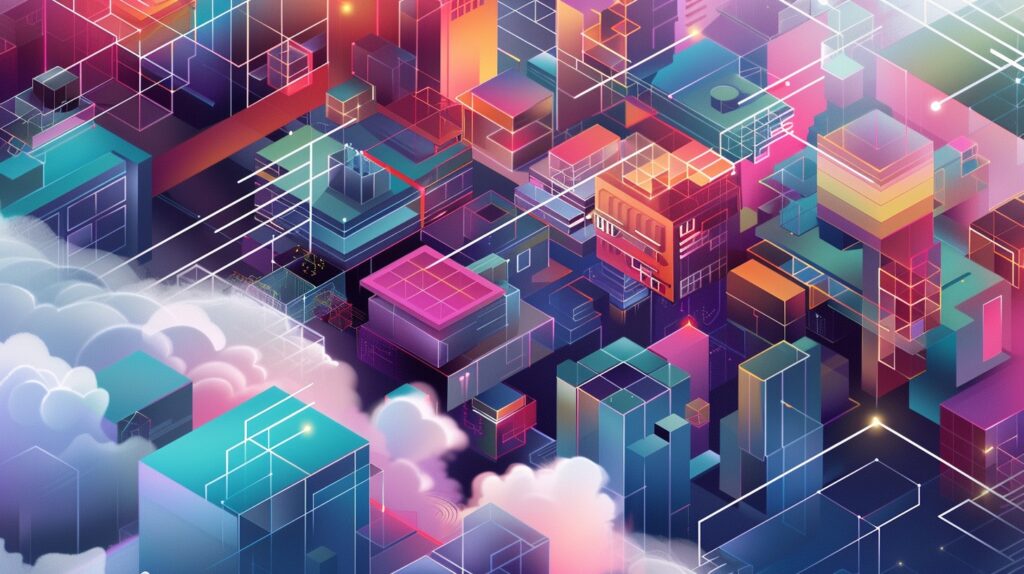By Marcelo Mota and EloInsights
- This article examines the differences between microservice and monolithic architectures, highlighting how each one of them can affect the development, maintenance and scalability of applications, as well as in which specific scenarios each model would be more advantageous.
- Whereas microservices are ideal for projects that require high scalability and technological independence, monolithic architectures are suitable for smaller projects, with faster and less complex development and deployment.
- Meet 10 important points that leaders should consider when choosing between microservices and monolithic, including scalability requirements, business complexity, team capacity and infrastructure costs.
In the world of software engineering, the choice of system architecture can determine the success or failure of an operation. A suitable architecture not only eases the implementation of functionalities in the short term, but also ensures that the system remains robust, flexible and scalable in the long term.
This choice directly affects operational efficiency, responsiveness to market demands and the ease with which recent updates or improvements can be implemented. In contrast, a poor choice can result in high maintenance costs, technical difficulties in adapting to new business needs and, in extreme cases, systematic failures that compromise the delivery of services and products.
In this article, we will address a modern dilemma faced by many organizations: the decision between microservices and monolithic architectures. These approaches are not just technologies, they stand for distinct philosophies with profound implications for the development, maintenance and scalability of applications.
We will delve into the concepts, advantages and disadvantages of each model, helping you to identify which strategy best aligns with your business goals.
The concept of systems architecture
Before diving deeper into the specifics of microservices and monolithic structures, let’s take a step back and remember what the concept of systems architecture is all about.
System architecture, in Software Engineering, refers to the structured set of guidelines that defines the organization of a software system. It covers the choice of components and their interaction, as well as describing how the system is divided into modules and how these modules interact with each other to form the complete system.
Essentially, systems architecture serves as a road map for software development, guiding developers in the construction, integration and maintenance of all parts of a system. This architecture is not only technical, but also a manifestation of business requirements and policies, translating operational and strategic needs and constraints into a technical solution. The main benefits of a well-defined architecture include:
- Maintenance: Eases software updates and management, since changes to one component can be made with minimal impact on the others;
- Scalability: Allows the system to grow in capacity, either by adding new modules or by scaling existing ones, without affecting performance;
- Reuse: Software components can be designed to be reused in distinct parts of the system or in different projects, reducing development time and cost; and
- Performance: Optimizes performance through an efficient arrangement of components and a clear definition of communications between them.
Systems architecture is a vital guide for development teams, ensuring that all aspects of the system are aligned with business aims and industry best practices, as well as being adaptable to future changes in both technology and business requirements.

What are microservices?
Microservices are a style of software architecture that structures an application as a collection of smaller services, each performing a unique process. This model appeared as a response to the challenges faced by monolithic architectures, especially in relation to scalability and development agility.
With microservices, teams can update services independently, improving resilience and the speed of delivery of new functionalities. Some of its advantages are:
- Independent scalability: Each service in a microservices architecture can be scaled independently, allowing resources to be distributed more efficiently. This is particularly useful in systems where different components have different load and performance requirements;
- Resilience: Failures in a microservice are isolated and therefore less likely to affect the entire system. This increases the overall resilience of the system, as the other services can continue to run normally while a failed service is repaired or restarted;
- Continuous deployment: The modular nature of microservices facilitates continuous updates and deployments without interrupting the service to the end user. Companies can deploy new versions of services individually without having to redeploy the entire application, which speeds up the release cycle for new features and fixes;
- Technological diversity: Microservices allow different services to be written in different programming languages and use different data storage technologies. This offers the flexibility to choose the most suitable technologies for the specific needs of each service; and
- Team autonomy: Teams can develop, test, deploy and scale their services independently of each other. This not only speeds up development, but also allows teams to be more innovative and responsive to changing business demands.
On the other hand, choosing this architecture can also have some disadvantages, such as:
- Management complexity: One of the biggest disadvantages of microservices is the added complexity in managing multiple independent services. This includes difficulties with monitoring, orchestrating services and managing dependencies between services;
- Data consistency: Keeping data consistency between services can be challenging, since each service can use its own database. This can result in complex problems with distributed transactions and eventual consistency;
- Infrastructure costs: Although microservices can be scaled independently, they also need more hardware and network infrastructure resources than an equivalent monolithic application. This can increase operating costs;
- Difficulty in carrying out comprehensive tests: Testing a microservices-based application can be more complicated than testing a monolith, as it requires setting up an environment that includes all the interdependent services, which can be both time consuming and error prone; and
- Security challenges: Each service is a potential point of security failure, and securing multiple interfaces can be more challenging than in a monolithic environment. In addition, the complexity of the network between services can create new vulnerabilities.
What are not microservices? AKA: What are monoliths?
In contrast to microservices, the monolithic model consists of a single, indivisible application in which all software components are interdependent and share the same code base.
Although some modern views criticize this model for its difficulty in scalability, it is still justifiable in many scenarios, especially for less complex applications, where the simplicity of development, testing and deployment can outweigh the advantages of microservices. Its advantages include:
- Simplicity of development: Monolithic architecture is generally simpler to develop and test because all parts of the application are integrated into a single development environment. This can make it easier to debug and implement functionalities;
- Ease of deployment: With a monolith, deployment is generally simpler as it only involves launching a single application or set of related files, without the need to manage multiple services or their interdependencies;
- Data consistency: In monolithic architectures, data management is more coherent and less prone to errors, as the entire application shares a single database. This simplifies transactions and maintaining data integrity;
- Lower communication overhead: Unlike microservices, the components of a monolith communicate with each other without the latency associated with network calls, which can result in better performance for certain operations; and
- Lower initial maintenance cost: For smaller projects or startups, monolithic architecture can be less costly in terms of maintenance and infrastructure, as it doesn’t require complex orchestration or extensive hardware and network resources.
Just like the microservices architecture, the monolith model may also present some disadvantages. Such as:
- Difficulty of scalability: Scaling a monolithic application can be challenging, especially when different modules have varying scalability requirements. This often results in the need to scale the entire application, even if only part of it is under high load;
- Complexity with growth: As a monolith grows, its code base can become excessively complex and difficult to manage. This can negatively affect maintainability and increase the risk of bugs;
- Slower deployment: Deploying new versions of a monolith can be slower and riskier, as any change affects the entire application. This can also lead to downtime during updates;
- Less technological flexibility: In a monolith, it is generally necessary to adhere to a single technological stack, which can limit the choice of technologies and experimentation with new approaches; and
- Barriers to innovation: The interdependent nature of a monolith can discourage innovation, as changes in one part of the system can have unforeseen repercussions in other parts.

Scenarios in which it makes sense to adopt microservices
Adopting microservices makes sense in scenarios that require high scalability, flexibility and agility in development. Companies that operate in dynamic environments and need to adapt quickly to market changes tend to benefit from this model.
Requirements such as the ability to implement frequent updates without interrupting the service to the end user are crucial. In addition, an organizational culture that supports team autonomy and strong coordination are essential for the success of this model.
Some examples of scenarios that tend to be more conducive to the adoption of microservices are:
- Large companies with scalability needs: Microservices are ideal for organizations that need to scale specific parts of their applications independently. This is particularly useful for services that experience variable peaks in demand;
- Agile development and rapid release cycles: Companies that adopt agile practices and need frequent, independent deployments between teams benefit significantly from microservices architecture. This allows different teams to work autonomously on different services without interfering with each other;
- Diversity of technologies and experimentation: If an organization wants to use different technologies (programming languages, databases, etc.) for distinct parts of its application, microservices are the ideal choice. This allows each team to select the most suitable stack for their specific needs; and
- Organizations with decentralized team structures: Microservices fit well in organizations where teams are geographically distributed or have quite different working cultures, as each team can manage its own service independently.
Hypothetical example of using microservices
Scenario: A large e-commerce company that offers a variety of products in diverse categories, such as electronics, clothing and food. The company wants to ensure that critical parts of its application, like the payment system and inventory management, can be updated quickly in response to market trends without disrupting other parts of the system.
Solution: By implementing a microservices architecture, the company divides its application into several smaller, independent services. For example:
- Inventory management service: Manages stocks and can be scaled separately during periods of high demand, such as during promotions or product launches; and
- Payment processing service: Running independently, it allows integration with multiple payment providers and can be quickly updated to add new payment options or strengthen security measures.
Result: The microservices structure allows the e-commerce company to innovate and adapt quickly, improving the user experience while supporting operational stability. Critical updates can be made to a specific service without the need to take down the entire system, reducing risk and minimizing downtime.
Scenarios in which it does not make sense to adopt microservices
Although attractive, microservices are not the ideal solution for all scenarios. In contexts in which the complexity and costs of managing multiple independent services may outweigh the benefits, such as in startups or small companies with limited resources, the monolithic model may be preferable.
The simplicity of a monolith helps debugging, testing and deployment, especially when the development team is small, or the application does not require intensive scalability.
Some examples of scenarios that tend to be more conducive to the adoption of monolithic architectures:
- Small to medium-scale projects: For startups or companies that are developing products with less complex requirements and a well-defined scope, monoliths can be more practical. This simplifies development and maintenance, as there are fewer moving parts involved;
- Applications with less need for scalability: When scalability is not a critical factor, or the application serves a stable number of users, a monolithic architecture can be sufficient and more resource-efficient;
- Smaller or less specialized teams: In scenarios where the development team is small or does not have the specializations to deal with the complexity of microservices, a monolith can facilitate collaboration and code management; and
- Projects with short life cycles or budget constraints: Projects that need to be developed quickly with a limited budget can benefit from the simplicity and lower initial setup cost that a monolith offers.
Hypothetical example of the use of monoliths
Scenario: A startup is launching a scheduling platform for medical appointments. The system does not require high scalability initially, as it will be tested in a limited geographical region with a moderate number of users.
Solution: Implementing a monolithic architecture, the startup develops a single system that integrates user registration, appointment scheduling, doctor calendar management and notification functionalities. This allows the team to concentrate its efforts on a single code repository, facilitating integration and debugging, as well as reducing operational complexity.
Result: The simplicity of the monolithic system allows the startup to quickly deploy the platform with reduced development and maintenance costs. This also makes it easier to adapt and modify the system as the startup grows and learns more about the needs of its users. As the business expands and demand increases, the company can gradually consider the transition to microservices if necessary.
Conclusion
When choosing between microservice and monolithic architectures, IT leaders and business decision-makers must evaluate several factors to ensure that the decision supports both the current and future needs of the organization. Here are ten essential points to consider:
- Scalability requirements: Assess whether the application needs to scale independently per service or as a whole. Microservices offer better support for granular scalability, while monoliths may be sufficient for moderate scale;
- Business complexity: Consider the complexity of business operations. Companies with many interdependent services can benefit from the flexibility of microservices.
- Development team capacity: Consider the size and experience of the development team. Smaller or less specialized teams may find it easier to manage and understand a monolithic architecture;
- Organizational culture: Does the company culture support innovation and change? Microservices require a culture that promotes autonomy and distributed responsibility;
- Time to market: Determine the urgency of the product launch. Projects with tight deadlines can benefit from the simplicity and speed of developing a monolith;
- Technological flexibility: Assess the need to use different technologies. Microservices allow the adoption of different technologies for different services;
- Infrastructure costs: Consider the monetary impact of the necessary infrastructure. Microservices may require greater investment in orchestration tools and network infrastructure;
- Maintainability and system evolution: Think about the ease of keeping and updating the system. Microservices facilitate continuous updates without affecting the entire system, while monoliths can become complex and difficult to change over time;
- Risks and security: Consider the security challenges associated with each architecture. Microservices can present more security challenges due to their distributed nature; and
- Future vision and expansion: Think about the long-term future of the application. A microservices architecture can offer more flexibility to adapt to changes in business and technology requirements over time.
By weighing up these factors, leaders can make informed choices that align the software architecture with the strategic goals of the business, thus maximizing the return on investment in technology. EloGroup can help in this process, offering insights and support to navigate these complex decisions without favoring a specific architecture.












